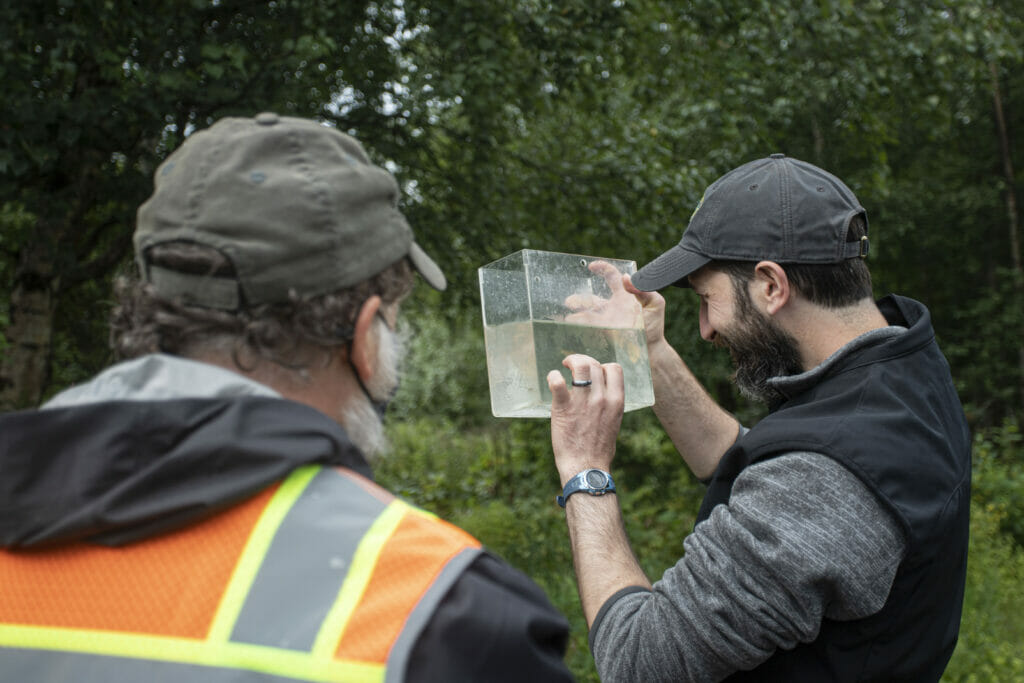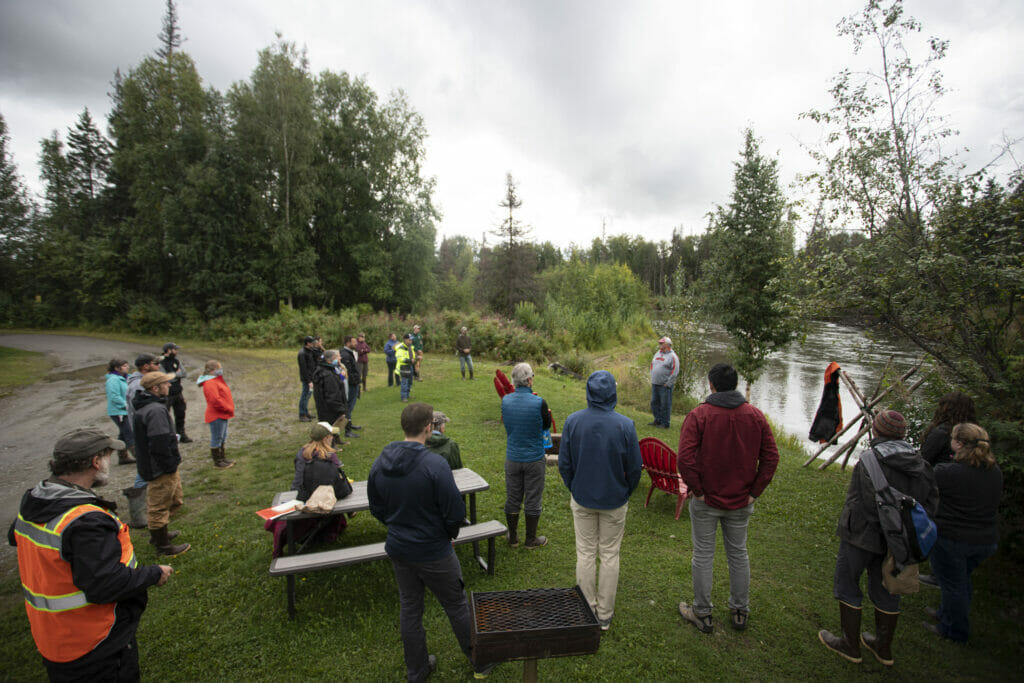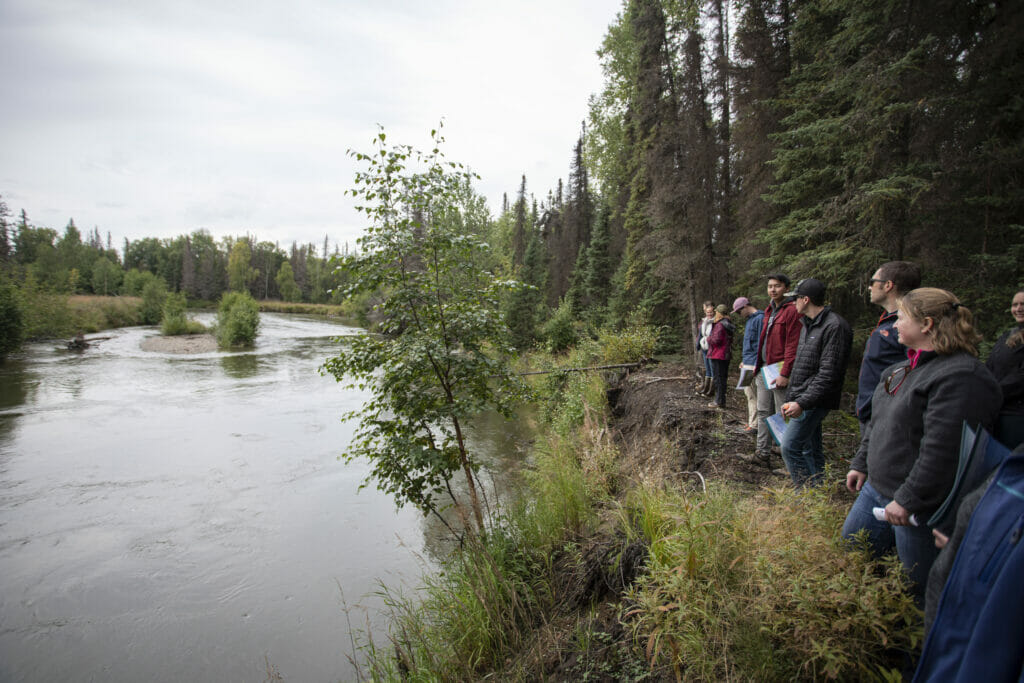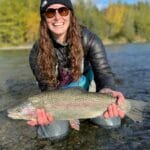A headwater stream of the Little Susitna River. Photo by Ted Eischeid.
On a rainy day in late August a group of diverse individuals gathered together on the banks of the Little Susitna River. Attendees included staff from state and federal wildlife agencies, tribal representatives, members of local government, political staffers from the governor and senator’s offices, conservation groups and academics. Everyone was brought together by a shared love of salmon and an interest in sustaining healthy fisheries in the Mat-Su Valley.
The fifth annual Mat-Su Basin Salmon Habitat Partnership Summer Site Tour was built around learning about the past, present and future of the Little Susitna River as a significant salmon producer and the role habitat has in keeping it so. The first stop of was at a headwater stream of the Little Susitna River in Hatcher Pass. There, attendees heard from Alaska Department of Fish & Game’s Samantha Oslund about the habitat that the river provides to five species of Pacific salmon, as well as Dolly Varden, rainbow trout, sculpin and stickleback. The 110 miles of the Little Susitna River support a major Chinook salmon fishery as well as the largest coho salmon fishery in the Northern Cook Inlet Management Area.

While the natural habitat of the Little Susitna River makes it a salmon producing powerhouse, it is not immune to challenges facing many other salmon streams across the country. One of these threats is warming water temperatures. The second site tour stop dove into the thermal requirements of salmon and current stream temperature monitoring efforts. The University of Alaska Anchorage and Cook Inletkeeper are working in collaboration with U.S. Fish and Wildlife Service to collect data on stream temperature, dissolved oxygen, discharge and juvenile salmon growth on the river. Sue Mauger, Becky Shaftel and Franklin Dekker addressed the importance of collecting this data to inform fishery management and conservation actions. As waters continue to warm, a robust knowledge of the temperatures across the Little Susitna River system and its effects on the salmon population will be vital to maintaining a healthy fish population.
Another threat Little Susitna salmon face is from aquatic invasive species. Alaska Department of Fish & Game’s Parker Bradley spoke to the threat of invasive pike during the site tour’s third stop. Northern pike are native to most of Alaska, but do not naturally occur in the Mat-Su Valley. Their illegal introduction in the 1950’s has led to invasive populations spreading to over 150 local waterbodies. Pike have been confirmed in seven lakes within the Little Susitna drainage and are likely in several more. They are voracious predators that feed on rearing salmonids. Their presence can have a significant impact on native species of salmon and trout. ADF&G is working on suppression and eradication projects throughout the region to address the problem. While pike are well established in the Mat-Su, other aquatic invasive species such as Elodea, Alaska’s first aquatic invasive plant, do not yet have a broad ranging foothold in the Mat-Su. Taking steps to prevent the spread of invasive species is best, but once they are found, it’s important to take care of the problem before it becomes too big and too expensive to fix.
The work highlighted during the site tour provides a view of habitat related efforts to keep the Little Susitna River one of the most productive fisheries in the Mat-Su Valley.
During the third stop Fishtale River Guides’ Andy Couch and Ted Eischeid of the Mat-Su Borough shared the significance of the economic and cultural value of this river to local residents. A 2017 study found that anglers spent $57.4 million in retail, supporting more than 370 jobs and providing $10.9 million in labor income in the Mat-Su Borough. Beyond economics, the Little Susitna River one of the best places in the valley for residents to sport fish and recreate. The decline of this fishery would have far-reaching negative effects within the community.

The day’s final stop ended on an uplifting note. David Mitchell of Great Land Trust presented on their effort to conserve priority salmon habitat in the Mat-Su Borough. GLT is currently working with the City of Houston on a land deal that will conserve 74 acres and over one mile of the Little Susitna River directly upstream of the Parks Highway. This project and the whole day’s itinerary make the future of the river look bright. The shared knowledge, passion and resolution of the organizations and guests gathered on the site tour are an incredible asset to the future of the Little Susitna River. This convening was organized by the Mat-Su Basin Salmon Habitat Partnership with support from Cook Inlet Aquaculture Association, Knik Tribal Conservation District, U.S. Fish & Wildlife Service, Bureau of Land Management, and Trout Unlimited. Special thanks to the Little Susitna RV and Camper Park, City of Houston and Alaska State Parks for being generous hosts.
The Partnership was founded in 2005 on a collaborative, cooperative and non-regulatory approach that brings together diverse stakeholders to coalesce and catalyze diverse interests around salmon and the conservation of their habitat. This model was inspired by an approach outlined by the National Fish Habitat Partnership, whose mission is to “protect, restore, and enhance the nation’s fish and aquatic conservation and improve the quality of life for the American people,” and was the first of three Fish Habitat Partnerships in Alaska. The Partnership operates under the guidance of NFHP and includes diverse membership from local community groups, federal, state, local and tribal governments, businesses, fishing interests, non-profit organizations and individual landowners. Since the beginning, the Partnership has sought to include anyone concerned about conserving salmon in the Mat-Su Basin.

The future of Mat-Su salmon depends upon what happens to them during each life stage, from their incubation and rearing in freshwater, to their maturation in saltwater, and their return back to freshwater to spawn. It is well known that freshwater habitat loss and fragmentation have been some of the primary drivers in the decline of anadromous fish in the U.S. and around the world. Based on lessons learned elsewhere, we also know that maintaining these functioning habitats is far more cost effective than trying to restore them once they are degraded. Therefore, the goal of the Mat-Su Salmon Habitat Partnership is to ensure that Mat-Su salmon have healthy habitat, from upper Cook Inlet throughout the Mat-Su Basin, and our top priority is to protect and maintain healthy habitat wherever possible.
In addition to hosting events, the Partnership awards funds each year to projects that conserve, restore, educate and provide the science to inform strategic salmon habitat conservation in the Mat-Su Basin. In 2021, $258,333 in funds were awarded to six different projects. Trout Unlimited Alaska is the fiscal sponsor of the Partnership and pleased to contribute to this worthy effort.



